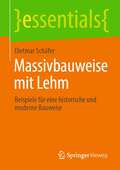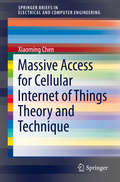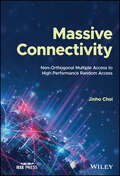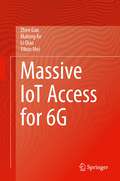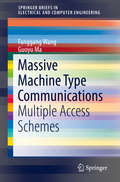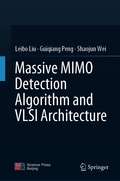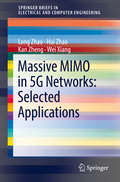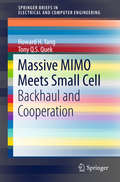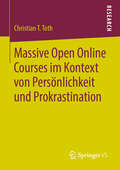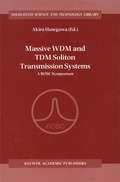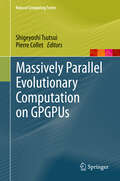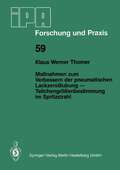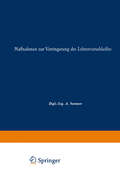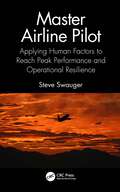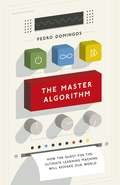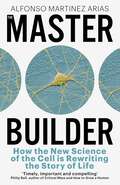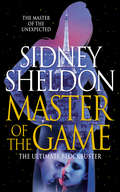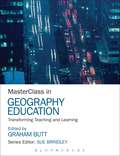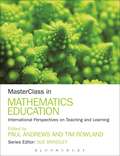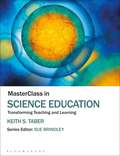- Table View
- List View
Massivbauweise mit Lehm: Beispiele für eine historische und moderne Bauweise (essentials)
by Dietmar SchäferDas Buch beschäftigt sich mit den Massivlehmbauweisen in Europa. Es werden Gemeinsamkeiten und Unterschiede der jeweiligen Lehmbautechnologien aufgezeigt.
Massive Access for Cellular Internet of Things Theory and Technique (SpringerBriefs in Electrical and Computer Engineering)
by Xiaoming ChenThis book focuses on massive access to the cellular internet of things (IoT). Both theory and technique are addressed, with more weight placed on the latter. This is achieved by providing in-depth studies on a number of central topics such as channel state information acquisition, user clustering, superposition coding, and successive interference cancellation. Four typical application scenarios are examined in detail, namely the stationary IoT device scenario, frequency division duplex-based low-mobility IoT device scenario, time-division duplex-based IoT device scenario, and high-mobility IoT device scenario. The comprehensive and systematic treatment of key techniques in massive access to the cellular IoT is one of the major features of the book, which is particularly suited for readers who are interested in finding practical solutions for the cellular IoT. As such, it will benefit researchers, engineers, and graduate students in the fields of information engineering, telecommunications engineering, computer engineering, etc.
Massive Connectivity: Non-Orthogonal Multiple Access to High Performance Random Access (IEEE Press)
by Jinho ChoiMassive Connectivity Learn to support more devices and sensors in Internet of Things applications through NOMA and machine-type communication Non-orthogonal multiple access (NOMA) has held much interest due to its ability to provide a higher spectral efficiency—such as more bits per unit bandwidth in Hertz—than other, orthogonal multiple access schemes. The majority of this research focuses on the application of NOMA to downlink channels (from base station to users) in cellular systems as its use for uplink (users to base station) is somewhat circumscribed. However, NOMA has recently been employed in contention-based uplink access, which has shown an improvement in performance that allows an increase in the number of users that can be supported. As a result, NOMA is promising for machine-type communication (MTC) in 5G systems and beyond, making it a key enabler of the Internet of Things (IoT). Massive Connectivity provides an in-depth, comprehensive view of the benefits and drawbacks of uplink NOMA random access (RA) systems. This text offers a basic introduction and description of uplink NOMA RA systems before considering the possibilities for evolution of the scheme as attempts are made to derive the most benefits and overcome any weaknesses. The book further presents key performance analysis while also highlighting game-theoretic views. In essence, by describing the essential properties of stable and high-throughput yielding RA systems, the book demonstrates that uplink NOMA can fulfill these required properties. Massive Connectivity readers will also find: An extensive literature survey on RA systems and their applications since the 1970s Recent advances in random access for massive connectivity Retransmission control algorithms for NOMA random access Discussion of how uplink NOMA random access systems can be integrated into the existing long-term evolution (LTE) or upcoming 5G cellular networks Massive Connectivity is a useful reference for field engineers and academics, as well as experts for random access systems for IoT applications.
Massive Connectivity: Non-Orthogonal Multiple Access to High Performance Random Access (IEEE Press)
by Jinho ChoiMassive Connectivity Learn to support more devices and sensors in Internet of Things applications through NOMA and machine-type communication Non-orthogonal multiple access (NOMA) has held much interest due to its ability to provide a higher spectral efficiency—such as more bits per unit bandwidth in Hertz—than other, orthogonal multiple access schemes. The majority of this research focuses on the application of NOMA to downlink channels (from base station to users) in cellular systems as its use for uplink (users to base station) is somewhat circumscribed. However, NOMA has recently been employed in contention-based uplink access, which has shown an improvement in performance that allows an increase in the number of users that can be supported. As a result, NOMA is promising for machine-type communication (MTC) in 5G systems and beyond, making it a key enabler of the Internet of Things (IoT). Massive Connectivity provides an in-depth, comprehensive view of the benefits and drawbacks of uplink NOMA random access (RA) systems. This text offers a basic introduction and description of uplink NOMA RA systems before considering the possibilities for evolution of the scheme as attempts are made to derive the most benefits and overcome any weaknesses. The book further presents key performance analysis while also highlighting game-theoretic views. In essence, by describing the essential properties of stable and high-throughput yielding RA systems, the book demonstrates that uplink NOMA can fulfill these required properties. Massive Connectivity readers will also find: An extensive literature survey on RA systems and their applications since the 1970s Recent advances in random access for massive connectivity Retransmission control algorithms for NOMA random access Discussion of how uplink NOMA random access systems can be integrated into the existing long-term evolution (LTE) or upcoming 5G cellular networks Massive Connectivity is a useful reference for field engineers and academics, as well as experts for random access systems for IoT applications.
Massive Decken zwischen eisernen Trägern und Angaben über Tragfähigkeit, Belastungen und zulässige Beanspruchung
by Stahlwerks-Verband A.-G.Massive IoT Access for 6G
by Zhen Gao Malong Ke Li Qiao Yikun MeiThe Internet-of-Things (IoT) revolution has triggered the need of massive connectivity for billions of devices requiring a system capacity which is far beyond the current network designs that can be supported. This emerging requirement has reshaped the society and industry in pursuing efficient communication paradigm. In particular, massive machine-type communications (mMTC) will be a prime driver for enabling the vision of scalable IoT with heterogeneous applications, where the massive access is of paramount importance. This book discusses important massive IoT scenarios and the key technical requirements of the corresponding massive access. We review the state-of-the-art IoT standards and mMTC solutions, and summarize the limitations of the existing schemes from the perspectives of the network architecture, random access procedure, and multiple access techniques. Here, we specify the massive access challenges and reveal that the facilitation of MTC invokes a dramatically different access scheme from current ones mainly designed for human-centric communications. Moreover, we propose several promising massive access solutions to overcome the limitations, where sufficient theoretical model and algorithm design guidance are provided. Besides, detailed simulation and engineering implementation methods are also included.
Massive Machine Type Communications: Multiple Access Schemes (SpringerBriefs in Electrical and Computer Engineering)
by Fanggang Wang Guoyu MaThis SpringerBrief introduces the current research status on emerging multiple access schemes for mMTC, which provides an integrated reference for future research works. A brief introduction on mMTC scenario is provided, and then the suitable random access procedure is discussed. Various multiple access schemes for mMTC are also described and analyzed in detail. It assumes a background in communication theory and wireless communication fundamentals. With the thriving of Internet of Things (IoT) industry, an emerging scenario named massive machine-type communication (mMTC) is considered in the future 5G networks. One main challenge in mMTC is how to support massive connections with limited radio resources and low energy consumption. Therein, novel multiple access scheme is the key to overcome the challenge. This SpringerBrief targets researchers and engineers, who are engaged in 5G and future IoT related communications system. It can also be a used as a reference book or a secondary text for graduate students, who major in communications.
Massive MIMO Detection Algorithm and VLSI Architecture
by Leibo Liu Shaojun Wei Guiqiang PengThis book introduces readers to a reconfigurable chip architecture for future wireless communication systems, such as 5G and beyond. The proposed architecture perfectly meets the demands for future mobile communication solutions to support different standards, algorithms, and antenna sizes, and to accommodate the evolution of standards and algorithms. It employs massive MIMO detection algorithms, which combine the advantages of low complexity and high parallelism, and can fully meet the requirements for detection accuracy. Further, the architecture is implemented using ASIC, which offers high energy efficiency, high area efficiency and low detection error. After introducing massive MIMO detection algorithms and circuit architectures, the book describes the ASIC implementation for verifying the massive MIMO detection. In turn, it provides detailed information on the proposed reconfigurable architecture: the data path and configuration path for massive MIMO detection algorithms, including the processing unit, interconnections, storage mechanism, configuration information format, and configuration method.
Massive MIMO in 5G Networks: Selected Applications (SpringerBriefs in Electrical and Computer Engineering)
by Long Zhao Hui Zhao Kan Zheng Wei XiangThis SpringerBrief focuses mainly on the basic theory and applications of massive MIMO in 5G networks. The significance of massive MIMO for 5G or future communications is first briefly discussed. Then, the basic theory of massive MIMO technology is comprehensively analyzed, i.e., a variety of 5G scenarios and their improvements are described when massive MIMO is taken into account. Art physical-layer techniques and various networking techniques for interference mitigation and resource scheduling are introduced as well. This SpringerBrief also examines the selected applications of massive MIMO in 5G networks, i.e., massive MIMO-aided millimeter communications and energy transfer. The physical-layer design, multiple access control (MAC) mechanism and networking techniques are discussed for millimeter-wave communications aided by massive MIMO technology. Then, massive MIMO is covered for hybrid information and energy transfer. A downlink precoder and a uplink pilot scheme is proposed for single cell networks, and both non-cooperative and cooperative energy transfer in multi-cell are presented. Communication researchers in the area of MIMO technology, as well as researchers and practitioners working in millimeter communications and energy transfer seeking new research topics, and topic areas with communication system design, centralized and distributed algorithms, will find this brief useful as a reference. Advanced-level students studying communication engineering will also find this book useful as a secondary text.
Massive MIMO Meets Small Cell: Backhaul and Cooperation (SpringerBriefs in Electrical and Computer Engineering)
by Howard H. Yang Tony Q.S. QuekThis brief explores the utilization of large antenna arrays in massive multiple-input-multiple-output (MIMO) for both interference suppression, where it can improve cell-edge user rates, and for wireless backhaul in small cell networks, where macro base stations can forward data to small access points in an energy efficient way. Massive MIMO is deemed as a critical technology for next generation wireless technology. By deploying an antenna array that has active elements in excess of the number of users, massive MIMO not only provides tremendous diversity gain but also powers new aspects for network design to improve performance. This brief investigates a better utilization of the excessive spatial dimensions to improve network performance. It combines random matrix theory and stochastic geometry to develop an analytical framework that accounts for all the key features of a network, including number of antenna array, base station density, inter-cell interference, random base station deployment, and network traffic load. The authors explore the impact from different network parameters through numerical analysis.Researchers in wireless network design will find this to be an exceptional resource, as will advanced-level students or professionals working in networking and information systems design.
Massive Open Online Courses im Kontext von Persönlichkeit und Prokrastination
by Christian T. TothChristian T. Toth untersucht den Einfluss von Persönlichkeitsfaktoren und dem Prokrastinationsverhalten von Teilnehmern und Teilnehmerinnen in Massive Open Online Courses (MOOCs). Der Autor bettet die Forschungsergebnisse in eine Rezeption und Systematisierung der internationalen MOOC-Forschung ein und diskutiert sie hinsichtlich ihrer Bedeutsamkeit für die (Weiter-)Entwicklung. Schließlich werden die Ergebnisse, auch bezogen auf den digital divide, aus einer gesellschaftsanalytischen Perspektive gedeutet. Die Basis der vorliegenden Forschung sind die in Kooperation mit dem MOOC-Provider ‚Iversity‘ erhobenen Daten aus vier internationalen MOOCs.
Massive WDM and TDM Soliton Transmission Systems: A ROSC Symposium (Solid-State Science and Technology Library #6)
by Akira HasegawaThis book summarizes the proceedings of the invited talks presented at the “International Symposium on Massive TDM and WDM Optical Soliton Tra- mission Systems” held in Kyoto during November 9–12, 1999. The symposium is the third of the series organized by Research Group for Optical Soliton C- munications (ROSC) chaired by Akira Hasegawa. The research group, ROSC, was established in Japan in April 1995 with a support of the Japanese Ministry of Post and Telecommunications to promote collaboration and information - change among communication service companies, communication industries and academic circles in the theory and application of optical solitons. The symposium attracted enthusiastic response from worldwide researchers in the field of soliton based communications and intensive discussions were made. In the symposium held in 1997, new concept of soliton transmission based on dispersion management of optical fibers were presented. This new soliton is now called the dispersion managed soliton. The present symposium mainly focuses the theoretical and experimental developments of dispersion managed solitons. It is remarkable that the concept of the dispersion managed soliton, which was just born two years ago when the naming was not even given yet, has become the center of soliton research in two years. The dispersion managed soliton has an enhanced power in maintaining reasonable signal to noise ratio, yet has reduced Gordon-Haus timing jitter by reduced averagedispersion. The dispersion managed soliton also has demonstrated its power in soliton based WDM transmissions.
Massively Parallel Evolutionary Computation on GPGPUs (Natural Computing Series)
by Shigeyoshi Tsutsui and Pierre ColletEvolutionary algorithms (EAs) are metaheuristics that learn from natural collective behavior and are applied to solve optimization problems in domains such as scheduling, engineering, bioinformatics, and finance. Such applications demand acceptable solutions with high-speed execution using finite computational resources. Therefore, there have been many attempts to develop platforms for running parallel EAs using multicore machines, massively parallel cluster machines, or grid computing environments. Recent advances in general-purpose computing on graphics processing units (GPGPU) have opened up this possibility for parallel EAs, and this is the first book dedicated to this exciting development. The three chapters of Part I are tutorials, representing a comprehensive introduction to the approach, explaining the characteristics of the hardware used, and presenting a representative project to develop a platform for automatic parallelization of evolutionary computing (EC) on GPGPUs. The 10 chapters in Part II focus on how to consider key EC approaches in the light of this advanced computational technique, in particular addressing generic local search, tabu search, genetic algorithms, differential evolution, swarm optimization, ant colony optimization, systolic genetic search, genetic programming, and multiobjective optimization. The 6 chapters in Part III present successful results from real-world problems in data mining, bioinformatics, drug discovery, crystallography, artificial chemistries, and sudoku. Although the parallelism of EAs is suited to the single-instruction multiple-data (SIMD)-based GPU, there are many issues to be resolved in design and implementation, and a key feature of the contributions is the practical engineering advice offered. This book will be of value to researchers, practitioners, and graduate students in the areas of evolutionary computation and scientific computing.
Maßnahmen zum Verbessern der pneumatischen Lackzerstäubung — Teilchengrößenbestimmung im Spritzstrahl (IPA-IAO - Forschung und Praxis #59)
by K.W. ThomerMaßnahmen zur Verringerung des Lehrenverschleißes (Fertigung und Betrieb)
by A. SommerDieser Buchtitel ist Teil des Digitalisierungsprojekts Springer Book Archives mit Publikationen, die seit den Anfängen des Verlags von 1842 erschienen sind. Der Verlag stellt mit diesem Archiv Quellen für die historische wie auch die disziplingeschichtliche Forschung zur Verfügung, die jeweils im historischen Kontext betrachtet werden müssen. Dieser Titel erschien in der Zeit vor 1945 und wird daher in seiner zeittypischen politisch-ideologischen Ausrichtung vom Verlag nicht beworben.
Master Airline Pilot: Applying Human Factors to Reach Peak Performance and Operational Resilience
by Steve SwaugerMaster Airline Pilot offers a process for improving pilots’ skills in risk management, situational awareness building, decision making, communications, and crew management. It links aviation human factors with practical airline operations to promote the development of master-level aviation skills across the full range of pilot experience. Serving as a practical guide for operational aviation challenges, the book discusses exceptional events such as operations under marginal condition, intervening to interdict an unsafe operation, and resolving crew conflicts. It also provides techniques for handling more common airline flying challenges like delays, holding, diverting, and continuing versus aborting a deteriorating game plan. The book is intended for airline pilots, training captains, simulator instructors, and aviation students taking courses in flight safety and crew management to improve their skillset, proficiency, and expertise toward peak performance.
Master Airline Pilot: Applying Human Factors to Reach Peak Performance and Operational Resilience
by Steve SwaugerMaster Airline Pilot offers a process for improving pilots’ skills in risk management, situational awareness building, decision making, communications, and crew management. It links aviation human factors with practical airline operations to promote the development of master-level aviation skills across the full range of pilot experience. Serving as a practical guide for operational aviation challenges, the book discusses exceptional events such as operations under marginal condition, intervening to interdict an unsafe operation, and resolving crew conflicts. It also provides techniques for handling more common airline flying challenges like delays, holding, diverting, and continuing versus aborting a deteriorating game plan. The book is intended for airline pilots, training captains, simulator instructors, and aviation students taking courses in flight safety and crew management to improve their skillset, proficiency, and expertise toward peak performance.
The Master Algorithm: How the Quest for the Ultimate Learning Machine Will Remake Our World
by Pedro DomingosA spell-binding quest for the one algorithm capable of deriving all knowledge from data, including a cure for cancerSociety is changing, one learning algorithm at a time, from search engines to online dating, personalized medicine to predicting the stock market. But learning algorithms are not just about Big Data - these algorithms take raw data and make it useful by creating more algorithms. This is something new under the sun: a technology that builds itself. In The Master Algorithm, Pedro Domingos reveals how machine learning is remaking business, politics, science and war. And he takes us on an awe-inspiring quest to find 'The Master Algorithm' - a universal learner capable of deriving all knowledge from data.
The Master Builder: How the New Science of the Cell is Rewriting the Story of Life
by Alfonso Martinez AriasWhat defines who we are? Until now, the biological answer has been our genes. Leading biologist Alfonso Martinez Arias breaks with popular tradition to make a bold argument: what defines us is our cells. Drawing on groundbreaking research, he reveals that we are composed of a thrillingly complex, constantly rearranging symphony of cells that know how to count, feel, and give form to our bodies. While DNA is important, nothing in your genes explains why your heart is on the left, why you have five fingers and not ten, why genetically identical twins have different sets of fingerprints, or why it's possible for a mother to apparently share no DNA with the children she gave birth to! At the heart of it all is a powerful new conception of the essence of life. Our identities are shaped by the interconnections between cells, working cooperatively, creating something greater than its parts - the unbroken lineage that connects us to the fertilized egg from which we developed and back through the billions of years of our planet's history, to the very first cell of all life on Earth. A sweeping revision of both the present and the history of life, The Master Builder puts forward a new paradigm for understanding biology, transforming our approach to where we come from, what shapes us, and where we are going - as individuals, a species, and the community of life itself.
Master of the Game (Compass Ser.)
by Sidney SheldonOne of Sidney Sheldon’s most popular and bestselling titles, published in ebook format for a new generation of fans.
MasterClass in Geography Education: Transforming Teaching and Learning (MasterClass)
by Sue BrindleyMasterClass in Geography Education provides a comprehensive exploration of the major themes in geography education research and pedagogy, drawing on international research. The editor draws together a variety of professional, academic and practitioner perspectives to support professional development of geography teachers. The book incorporates discussion of the place of subject knowledge in geography, the role and function of research in geography education and the relationship between research and practice.Topics covered include:- research and professional practice- constructing geographical knowledge- ethical considerations- carrying out research projectsMasterClass in Geography Education will be essential reading for all studying the teaching and learning of geography on PGCE and Education MEd/MA courses.
MasterClass in Geography Education: Transforming Teaching and Learning (MasterClass)
by Graham Butt Sue BrindleyMasterClass in Geography Education provides a comprehensive exploration of the major themes in geography education research and pedagogy, drawing on international research. The editor draws together a variety of professional, academic and practitioner perspectives to support professional development of geography teachers. The book incorporates discussion of the place of subject knowledge in geography, the role and function of research in geography education and the relationship between research and practice.Topics covered include:- research and professional practice- constructing geographical knowledge- ethical considerations- carrying out research projectsMasterClass in Geography Education will be essential reading for all studying the teaching and learning of geography on PGCE and Education MEd/MA courses.
MasterClass in Mathematics Education: International Perspectives on Teaching and Learning (MasterClass)
by Paul Andrews Tim Rowland Sue BrindleyMasterClass in Mathematics Education provides accessible links between theory and practice and encourages readers to reflect on their own understanding of their teaching context.Each chapter, written by an internationally respected authority, explores the key concepts within the selected area of the field, drawing directly on published research to encourage readers to reflect on the content, ideas and ongoing debates. Using international case studies, each chapter will encourage readers to think about ways that the teaching and learning of mathematics reflect different cultural traditions and expectations and enable them to evaluate effective strategies for their own contexts.
MasterClass in Mathematics Education: International Perspectives on Teaching and Learning (MasterClass)
by Paul Andrews Tim Rowland Sue BrindleyMasterClass in Mathematics Education provides accessible links between theory and practice and encourages readers to reflect on their own understanding of their teaching context.Each chapter, written by an internationally respected authority, explores the key concepts within the selected area of the field, drawing directly on published research to encourage readers to reflect on the content, ideas and ongoing debates. Using international case studies, each chapter will encourage readers to think about ways that the teaching and learning of mathematics reflect different cultural traditions and expectations and enable them to evaluate effective strategies for their own contexts.
MasterClass in Science Education: Transforming Teaching and Learning (MasterClass)
by Keith S. TaberWorried about teaching natural selection, submicroscopic particle models or circuits? Keith S. Taber explores a range of issues faced in secondary science teaching and discusses strategies for teaching the nature of scientific knowledge, making practical work effective and challenging gifted young scientists.MasterClass in Science Education shows how to become a master science teacher by developing and adopting the habits and mind-set of a teacher-as-scientist. The author introduces the three pillars of this approach: subject knowledge, pedagogic knowledge, and classroom research. The body of subject knowledge in the sciences is both vast and constantly evolving as it is challenged, updated and developed, and this text supports you to understand the dynamic nature of knowledge and the implications this has for your teaching. Taber shows how to use a knowledge-in-action approach, enacting knowledge in the complex and dynamic classroom environment. He supports you to critically examine classroom experiences, drawing on a wide-range of research-informed perspectives that offer insights into facilitating effective student learning. He also guides you to understand how to use recommendations from published research studies as components of a toolkit to improve your teaching and learning.
